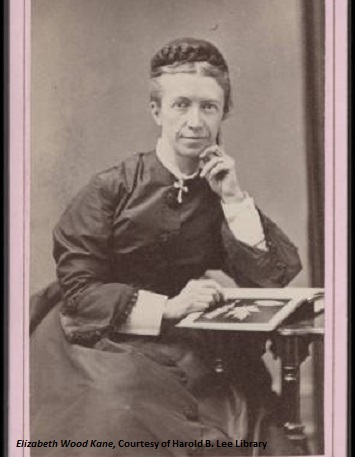Dublin Core
Title
Description
After Elizabeth Wood Kane arrived in Utah with her husband, her letters home became the manuscript for a book about Utah culture. Her writings shed some important light on the frontier and Mormon social customs.
Most students of Utah history are at least familiar with the aid Pennsylvanian Thomas L. Kane gave the territory’s early colonizers. Not only did Kane help Mormon refugees fleeing westward from Illinois in 1846, but he also attempted to mediate between the federal government and the Mormons during the Utah War of the late 1850s. Less well known, however, is the way the Pennsylvanian’s wife, Elizabeth, affected our knowledge of Utah’s past.
Elizabeth Wood married Thomas Kane, her second cousin, in 1853, and moved to McKean County, Pennsylvania, where she raised four children. As Thomas’s relationship with Brigham Young and other Mormon leaders intensified over the ensuing decades, Elizabeth came to learn more about the Latter-day Saints’ Great Basin commonwealth. But it wasn’t until 1872 that she was able to witness it firsthand on an extended visit to Utah. The letters she sent home from the West, coupled with her journal of the experience, became the manuscript for the book Twelve Mormon Homes, which her father published in 1874. As an outside observer of Utah culture, Elizabeth shed light on a variety of important subjects including frontier social customs, Mormon-Indian relations, polygamy, Latter-day Saint worship, the territory’s natural environment, and pioneer Utah architecture. Her descriptions of Utah’s landscape are especially textured. Utah Lake, she wrote, was a “shining sheet of fresh water” and near its shore “were several flourishing villages, appearing in the distance as large fruit-orchards, with detached dwellings scattered through them.” About Beaver she humorously recalled being told “that no mice existed there because the soil was too hard for them to work.” Of the settlers’ penchant for using adobe bricks for construction, she wrote that their “general tint is of a soft dove-color, which looks well under the trees.” And when the Mormons whitewashed the adobe, she wrote, “its dazzling whiteness commends it to the housekeeper’s, if not to the artist’s, eye.”
Creator
Source
Image: Photograph of Elizabeth Wood Kane. This photo was likely taken around the time she visted Utah in the winter of 1872-1873. Courtesy of Harold B. Lee Library.
_______________
See Elizabeth Wood Kane, Twelve Mormon Homes: Visited in Succession on a Journey through Utah to Arizona, introduction and notes by Everett L. Cooley (Salt Lake City: Tanner Trust Fund and the University of Utah Library, 1974).

